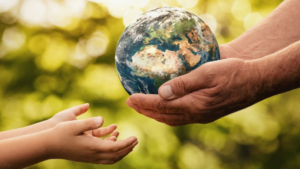Global warming refers to the gradual increase in the Earth’s surface temperature. Over the past five decades, the average global temperature has increased at the fastest rate in recorded history. Global warming is caused by human activities that increase the emission of greenhouse gases such as carbon dioxide. Individuals can measure how much they contribute to global warming by working out their carbon footprint. This calculates the amount of greenhouse gases generated by your day-to-day activities.
How is global warming caused?
Global warming is caused by the greenhouse effect. The greenhouse effect occurs when carbon dioxide and other greenhouse gases, such as methane and nitrous oxide, collect in the atmosphere. Humans cause an increase in greenhouse gases by burning fossil fuels, such as oil and coal, for energy. The same effect is also generated with cars when they burn fuel.
The greenhouse gases cause global warming when they absorb sunlight and solar radiation that have bounced off the Earth’s surface. The gases trap the heat so that it cannot escape into space, just like heat is trapped in a greenhouse. This causes the planet to get hotter.
Greenhouse gases also affect the ozone layer. We are protected from harmful ultra-violet radiation by the ozone layer. The ozone layer is damaged by greenhouse gases, which exposes us to the harmful rays and causes a rise in the Earth’s temperature. Cutting down trees has also contributed to global warming. When trees photosynthesise, they absorb carbon dioxide, which reduces the amount of it in the atmosphere. Deforestation means that less carbon dioxide is being removed from the air.
Global warming isn’t exclusively caused by human activity, though. Volcanic eruptions and other natural phenomena such as the Earth’s position relative to the sun also plays a role. However, human activity has the greatest impact on greenhouse gas emissions. In fact, since the industrial revolution, concentrations of greenhouse gases have increased by more than a third.

What are the consequences of global warming? Why is it a problem?
There is a lot of research that suggests that the global temperature could rise more than two degrees Celsius by the end of the century. This has already had an observable impact on glaciers, as they’ve begun to shrink. There are many other predicted consequences of global warming, including:
- Extreme weather conditions: Some research suggests that extremely wet winters could become up to five times more likely over the next one hundred years. This increases the chance of flooding, which puts homes, businesses and infrastructure at risk. The U.K. could also experience extreme heat in the summer, which might cause droughts. Droughts compromise access to drinking water and fuel out-of-control forest fires. This again endangers lives and habitats.
- Heat-related illnesses: According to a 2009 U.K. Climate Projections report, the mean annual temperatures could rise by five degrees Celsius by 2080. This might cause an increase in heat-related mortality. Another health concern related to rising heat temperatures is the possible spread of diseases such as malaria.
- Threats to wildlife and biodiversity: Extreme weather conditions pose a substantial risk to damaging various animal habitats and species’ ecosystems. Extreme heat in summer and extreme cold in winter could also affect agriculture. As ecosystems are under threat, existing stress factors such as pollution and land conversion are exacerbated. Climate change might also affect the food available for species, which increases the risk of their extinction if they can’t adapt to the new conditions. Any disruption to the food chain can eventually have an impact on humanity, which means we need to protect all ecosystems for own survival.
Example
Polar bears are specially adapted to live in the Arctic. They have a remarkable sense of smell which helps them to catch seals – they can smell them from almost a kilometre away! They’re also well-equipped to survive the cold temperature with thick white coats and a layer of fat. The changes in their habitat caused by global warming mean that polar bears’ adaptations are redundant in surviving the new conditions. The rising temperatures are melting the sea-ice. This means that polar bears have to walk and swim further to get to ice where they can hunt for seals. Polar bears need around 12,000 calories a day (that’s about 23.6 McDonalds’ Big Macs), so this increase in distance means they’re wasting too much energy and beginning to starve as a result.
Polar bear extinction has significant consequences for humans. Polar bears have strong cultural significance for Arctic people (like cats for the Ancient Egyptians and pugs for millennials). They are also the top predators in the food web, which means they play a significant role in the balance of their ecosystem. We need to protect polar bears to ensure that the Arctic food chain stays healthy.


